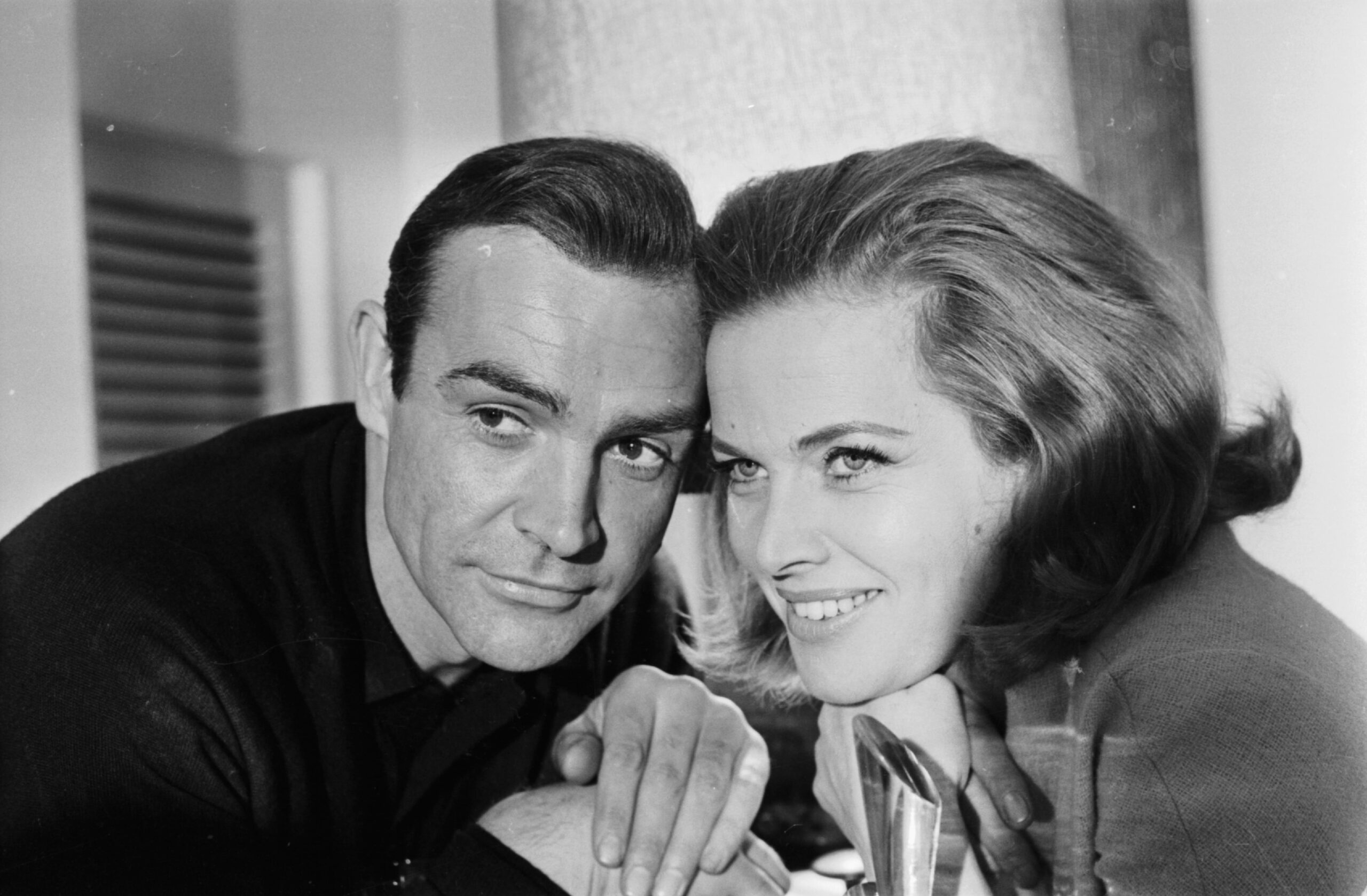“You expect me to talk?”
“No, Mr. Bond, I expect you to die!”
Even that small minority of the Earth’s population who wouldn’t normally watch a James Bond movie can quote that exchange from Goldfinger, spoken as Bond follows the progress of a laser beam pointed at that portion of his lower anatomy most required for his continued success as a womanizer. First released in the U.K. in September 1964 with a U.S. release to follow in December, the film’s other primary takeaway images are those of a nude young lady killed by being smothered in gold paint, a mute Korean assassin with an unusually lethal bowler hat, and an all-female flying circus, overseen by a blonde-framed vision named Pussy Galore, spraying nerve gas over Fort Knox, all accompanied by a breezily melodramatic title song belted out by Shirley Bassey with the young Jimmy Page, later of Led Zeppelin fame, on guitar.
All rich stuff, you may think, if just a touch on the outré side. The contemporaneous reviews used words like “outlandish,” “ludicrous,” and “absurd, funny, and vile” to describe the film, except for Roger Ebert, who called it “chilling,” and praised Sean Connery—the yardstick by which all his successors as Bond would be measured, often to their disadvantage—for conveying a “verisimilitude” and “sleek assurance” in the role, alongside a gift for deadpan comedy. Revisiting the film years later, Ebert wrote: “Connery . . . had something else that none of [his heirs] could muster: steely toughness. When his eyes narrowed and his body tensed up, you knew the playing was over and the bloodshed was about to begin.” Connery’s performance surmounted even one or two plot twists and chunks of expository dialogue that may seem a touch heavy-going to us today. The title character’s essential game plan is to profit from the economic chaos that will ensue after he’s detonated an atomic bomb over Fort Knox, thus rendering America’s gold reserves radioactive for a precisely stated fifty-eight years. “He’s quite mad, you know,” Bond remarks to Pussy Galore, just in case anyone watching might have considered it a viable get-rich-quick scheme.
I have to say that I’m with Ebert on this one. It’s not just that Connery is perfect as Bond, with a vitality and a humanity (not to mention that widely mimicked Scottish burr) his inheritors in the role could only approximate, some more competently than others. Strange as it may seem, Goldfinger itself, like many of the author Ian Fleming’s tales, wasn’t pure invention. It was inspired by the swashbuckling exploits of the Anglo-Canadian spymaster William Stephenson (1897–1989), whose wartime scheme to relieve the collaborationist Vichy French government of its bullion reserves held on the island of Martinique had come to Fleming’s attention as a young operative with British naval intelligence.
Maybe Stephenson’s plan didn’t actually call for its chief protagonist to introduce himself by stripping off the wetsuit he had used to approach his first adversary, revealing a perfectly pressed, shimmering white tuxedo underneath; nor to dally with a gorgeous belly-dancer; nor to do battle with a silent Korean henchman capable of crushing a golf ball in his bare hand; nor, for that matter, to drive a customized Aston Martin DB5 at wild speeds while demonstrating the car’s numerous accessories, such as its tire-shredding capabilities and slightly comical ejector seat—the last one of several tongue-in-cheek touches that lend the film much of its charm. Nor were the forces due to be dispatched to repatriate the French gold reserves expected to operate in an environment in which vehicles seemingly explode spontaneously, car chases initiate without warning, the hero is equipped with an implausible array of space-age gadgets, and every female character encountered en route is ripe for a roll in the hay—literally so in the case of Pussy Galore, played by the magnificent Honor Blackman.
At the end of the day, what’s to be said about Goldfinger that hasn’t been said already? It’s in many ways camp, silly, and not so much politically incorrect as utterly indifferent to anything but its own mission to entertain. It’s also a near-perfect distillation of the whole Bond formula that continues to engage vast worldwide audiences today. The hero, the antagonist, the girls, the cars, the one-liners, the wardrobe, and even the title, with which President Johnson (like his predecessor in office, a confirmed 007 fan) occasionally liked to taunt his 1964 presidential opponent, the Bond villain’s near-namesake Barry Goldwater: it’s everything you could reasonably want of an action movie in a nutshell.
Even if Goldfinger isn’t the best of the twenty-five-odd James Bond films to date, it’s the one that can stand as a surrogate for all the others.
Leaving aside the mechanics of the film, I think it most worth celebrating, or at least remembering, for two reasons. The first is what might be called its artistic legacy. Whatever we’re to make of some of its present-day spawn, Goldfinger was one of the very first examples of what we now regard as the “blockbuster” genre. By that I mean not only that it was a pioneer in assembling the ingredients for a highly successful and lucrative movie franchise but also that it set the bar in terms of its accessory-heavy marketing campaign. Even as Goldfinger’s irresistible title song climbed the charts on both sides of the Atlantic, there would be posters, photos, badges, buttons, wallets, playing cards, and “exclusive merchandise” involving everything from 007 resin dolls to luridly illustrated lunchboxes. If you could wear it or carry it, Bond was on it. I happened to be detained at a seaside English boarding school at the time of the film’s release, and can confirm that it was a kind of social death to be seen without at least one of the many pocket-sized versions of Bond’s distinctive Aston Martin, preferably the model that came in gold paint, in one’s possession at all times.
You may think that I extrapolate too far from the relatively innocent pleasures of a film that could reasonably be deemed family entertainment to some of the morally vacuous and/or sanguinary horrors that constitute the modern Hollywood epic. But consider the evidence. Any reasonably coherent source material (like Fleming’s original 1959 novel) bowdlerized by studio executives anxious to maximize what they term their “branded asset”—that’s Goldfinger. Any film that relegates such matters as plot and character development to the background in favor of ever-more extravagant and stylized set pieces and brazenly sexualized dialogue—that’s Goldfinger. The notion that the average audience member has an attention span measurable not in hours or minutes but in seconds, and that he or she must therefore be diverted by a stream of crude double entendres and general lowbrow humor, or the idea that altogether more attention should be paid to a film’s CGI effects than to its script—all Goldfinger. Yes, it was, and remains, infinitely superior, in both its concept and execution, to many of its mutant offspring, as seen by the likes of the interminable Taken or Transformers series. But it still has a compelling paternity case to answer for.
It’s also worth noting in this context that even if Goldfinger isn’t the best of the twenty-five-odd James Bond films to date, it’s the one that can stand as a surrogate for all the others. If some evil Dr. No–like figure were to destroy all we know about the entire Bond canon, with only Goldfinger surviving, it’s a fair bet that we could reconstruct from it every outline of the basic formula, every essential character and flavor contributing to the franchise so many still flock to today. It’s also important as a link between the more modest first two Bond outings—Dr. No and From Russia With Love—and the later extravaganzas; after this one, with $46 million (or $690 million in today’s money) from its original run at the global box office, the producers could be certain that 007 was good for the long haul.
The other reason Goldfinger is so memorable is the broader historical context of its original release date in September 1964. This was an unusually febrile era in world affairs, and more particularly in East–West relations. Nikita Khrushchev was then still clinging to power in the Soviet Union, displaying that peculiar mix of the terrifying and the absurd that characterized his eleven years as the reigning red czar of the Kremlin. Speaking, for instance, of Berlin—the seemingly permanent crisis point of 1960s geopolitics—Khrushchev had remarked that if the West truly wanted a fight over the divided city, its own nations “might become a veritable cemetery” in the ensuing conflict. Any future war was bound to be thermonuclear, the Soviet dictator added, before noting that scientists had recently shown him “a monstrous new terrible weapon” that was “a means of the final destruction and extermination of humanity.” Perhaps unsurprisingly, much of the rhetoric of that fall’s U.S. presidential election concerned the prospect of man’s continued survival on the planet, as epitomized by Lyndon Johnson’s notorious “Daisy” TV commercial, in which a young girl was to be seen innocently picking petals as a booming male voice counted backwards from ten until the screen was filled by the flash of a simulated nuclear explosion. As viewers continued to watch the mushroom cloud, Johnson’s distinctive Texan voice exclaimed: “These are the stakes! To make a world in which all of God’s children can live, or to go into the dark. We must either love each other, or we must die!
I have to admit to treating with skepticism certain critics’ insistence that a given movie or book or song is in some way a potent metaphor for its times, and that this fact goes much of the way to explaining the product’s enduring popularity. It seems to me unlikely that many Americans consciously decided to drive out to their nearest multiplex and invest $1.50 for a ticket to Goldfinger because of its supposed allegorical insights into the culture. But it might be fair to say that the film’s central theme of Bond as the representative of British—or, by extension, Western—fortitude, ready and willing to meet any challenge in the most perilous circumstances, and thus to restore matters to their rightful order, was one much of the anxiety-ridden general public was ready to embrace. Therein, surely, lay Johnson’s own admiration for Fleming’s hard-edged hero. Bond is masculine, intrepid, rugged, gutsy, and a moral avenger for the times—all qualities the president aspired to.
Poignantly, Fleming himself would not live to see his story inspired by the Martinique gold reserves brought to the screen. On August 11, 1964, just over a month before Goldfinger’s premiere, the author went out to play a late afternoon round of golf with friends, then sat down to dinner and collapsed with a heart attack, dying early the following morning. Impeccably mannered, at least with strangers, to the end, Fleming’s last words, themselves displaying a certain 007 insouciance, were spoken to the crew of the ambulance taking him to the hospital. “I am terribly sorry to trouble you chaps,” he said, as he lay mortally stricken. “I don’t know how you get along so fast with the traffic on the roads these days.” The creator of the immortal Bond was just fifty-six at the time of his death.















